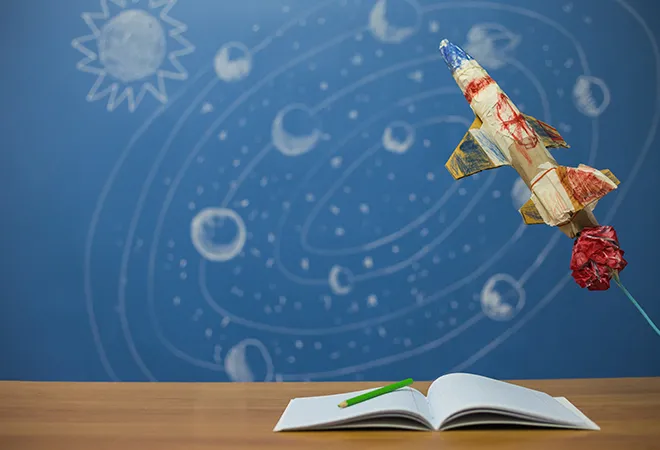
ORF: Uable’s focus on the 6-14 age group aims at developing the leaders of the next generation. Tell us how Uable is leveraging technology to achieve this.
Priyanka Subramanian: Uable in a learning company that is enabled by technology. Our vision is not to just use technology to make learning scalable but to leverage technology to enhance learning. Uable’s learners are all between the ages of six and 14 years, they are all digital natives, and naturally fascinated and comfortable with technology. We aim to build an online learning playground that exercises and celebrates creative intelligence.
We use the unique power of technology to provoke a learner’s imagination, build a sense of wonder, develop deep understanding and enable creation that pushes learners to exceed beyond expectations. A Uable learning experience does not have a learner sit in front of a device and passively consume content. Our learners are engaged in active, immersive learning experiences where they are creating, exploring and connecting with peers.
Research has proven that every child learns and expresses their learning differently. We focus on using tech-based tools to allow learners various opportunities and personalised pathways to engage with the learning process so that every learner can achieve their maximum potential. While we recognise that learning pathways need to be personalised, we also believe that learning is inherently social in nature. Hence, we are using technology to build a connected community that learns, creates and celebrates creative intelligence.
Uable is a social learning product that builds real world skills that lead to the development and harnessing of one’s creative intelligence. We are doing this by creating:
• Live online peer learning environments where learners engage in real life roles and build skills to become future ready
• Asynchronous tech-based DIY activities, challenges and quests that enable learners to continue on their learning pathways, develop their skills further and amplify their learning
• Creative intelligence skill-based assessments and benchmarking, designed to objectively benchmark, track and measure creative intelligence across various domains
• An online connected community where learners can showcase their creations to likeminded peers, educators and experts from across fields
ORF: You come from a non-technical background but are creating 360-degree learning experiences with the use of scalable technology platforms. How did you embark on the technical path and what advice do you have for others endeavouring the same?
PS: Yes, I do not possess a formal degree in technology, but technology has always been a friend to me. As a visual designer in the advertising industry, my tryst with technology began by understanding how it can enable the sharing of one’s creative vision with the world. As I grew professionally, my connection with technology grew stronger and most of my understanding is through very practical, learning-by-doing experiences.
My shift from visual design to education happened when I was offered an opportunity to be a fellow at Teach For India, a non-profit organisation that is part of the Teach for All network. I started off as a class teacher to an enthusiastic bunch of eight- and nine-year-olds in a Mumbai municipal school. Teach for India is geared towards ending education inequality in the country, but this audacious undertaking cannot be achieved without looking at scalable solutions. While I was a teacher in physical classrooms, all the learning was measured, tracked and gauged using tech-based tools. I was introduced to the methodology of data driven instruction, which helped identify where learning gaps existed and what can be done to bring students at par with expected learning standards. This led to achieving great success in pushing my students’ learning levels and bringing them up to grade level and some went even beyond expectation.
One of my strong takeaways from my first few years in the education field was that learning gaps exist all across the socio-economic spectrum, from low-income to high-income schools, and one of the challenges faced by most education institutions is how to identify these challenges early on for every child so it can be handled in a timely manner. Addressing this problem at scale can only be achieved through technology. This was when I made the decision to move into the education-technology space. My experience with educational initiatives introduced me to the various facets of tech driven learning and assessments. I applied all my learning when I worked on building the K12 assessment product at Pearson India. Our approach to tech-based formative and summative assessments tagged to the Blooms Taxonomy helped teachers, parents and students identify strengths and areas for improvement in learners, and we were able to showcase how our learning experiences were impacting learner achievement.
We at Uable are taking the 360-degree product approach to solve one of the most ignored problems in K12 learning today. We aim to harness the creative intelligence in a child and grow it to its maximum potential. We aim to not just look at how learners are faring on their evaluation but to dig deeper and innovate at every stage of the learning process from why they need to learn something, what they are learning, how they are learning, how much learning is being retained and how they are applying their learning in creative and inventive ways.
ORF: What lessons do you share for fellow entrepreneurs who want to Make in India and deliver world-class digital learning experiences to domestic and international customers?
PS: I personally think this is a glorious time for Make in India. We are privileged to have some of the greatest and sharpest minds the world has to offer. India has such a diverse demographic that it is slowly but surely becoming a representation of the global market. As entrepreneurs in India, we are put through the grind to build products that can work in various unpredictable conditions, suit multiple use cases, and that cater to various needs. This diverse but deep approach to product building is what sets us apart from the lot.
My strongest learning has been that one needs to stay close to the consumer no matter how fast you scale or how large you become. While we as entrepreneurs keep innovating to make our products and services more and more sticky, usable and scalable, it’s important to take your customer along on this journey of change.
Another learning that has stuck with me is that a lot of what a company can achieve is driven by the people you work with. Having a strong, diverse and ambitious team is what makes and breaks any company. Working with people who can be thought partners and thought leaders can be a catalyst for every company.
I am still very early in my entrepreneurial journey with Uable but every single day brings in new learnings and new perspectives. Having an agile approach and a growth mindset keeps me moving at through thick and thin.
ORF: Uable advocates the idea of creative intelligence, especially with the advent of artificial intelligence and a new era where routine jobs are becoming automated. How do you envision using creative intelligence as a metric to drive human capital development in India and beyond?
PS: The gaps that so many studies like NASA’s creative genius study (which concludes that creative genius of humans fall from 98 percent at the age of six to two percent by the time we are 18) and experts like Sir Ken Robinson (in his famous TED Talk) have highlighted for years are now being recognised, and India appears to be taking progressive steps to address it.
Our greatest joy in recent times has been seeing India’s New Education Policy (NEP) lifting off the ground. The NEP aims to bring in a more progressive and holistic approach to learning. It aims to bring creativity and innovativeness to learning to prepare children for life outside the classroom and focus on building important skills such as collaboration, creative thinking, problem-solving and logical reasoning, which have been neglected until now. The NEP notes, “Pedagogy must evolve to make education more experiential, holistic, integrated, inquiry-driven, discovery-oriented, learner-centred, discussion-based, flexible, and, of course, enjoyable.” The NEP is a validation of how creative intelligence is going to be one of the most fundamental and differentiating factors in ensuring the learners of today are geared towards achieving success in the future.
At Uable, we have designed a framework that can access, measure and grow a child’s creative intelligence. We aim to provide every learner with a personalised pathway to explore, develop and converge their skills in a way that will help them identify their own strengths and interests, eventually leading to making more aware decisions while selecting career pathways. This approach is developmentally informed and ensures that a child has clarity about his/her creative intelligence:
• Stage-1: 6-9 years (The early years: Exploration and skill development) This is the age when cognitive development is manifesting and about to hit its peak, and children are ready for exposure and skill development. This is the time when children start to learn from diverse peers, which is essential for holistic development and exploration. At Uable, they explore various real life roles like being an artist, author, performer, experimenter, inventor or coder, with a focus on developing fundamental skills.
• Stage-2: 10-12 years (The mid-years: Advanced skills and deeper exploration towards interest development) During this stage, Uable’s programmes and progressions help children focus on certain interest areas, take up accelerated/advanced pathways to develop those interests and a portfolio of work with ownership and autonomy.
• Stage-3: 13-15 years (Career exploration, mentoring, internships) As soon as a child enters the eighth or ninth grade, they are confronted with the same question from parents, peers and others—“What career path do you want to pursue?” At Uable, we believe everyone should always be free to explore further and change pathways, but some decisions taken at this age are likely to orient them towards certain career paths, universities and entrance exams. This can prove to be pivotal in defining how life unfolds hereon for them. During this stage, children go through advanced programmes on roles that suit their creative potential. They engage with deeper projects to build a stronger portfolio of work and connect with mentors in these selected areas to understand their own likes and dislikes well.
We believe that our approach of building a child’s creative intelligence and skill development through real life roles, and building a strong sense of self and community through our social, active learning pedagogy will result in confident, self-aware and entrepreneurial youth in the future.
The views expressed above belong to the author(s). ORF research and analyses now available on Telegram! Click here to access our curated content — blogs, longforms and interviews.




 PREV
PREV


